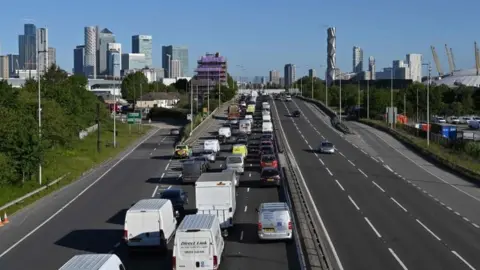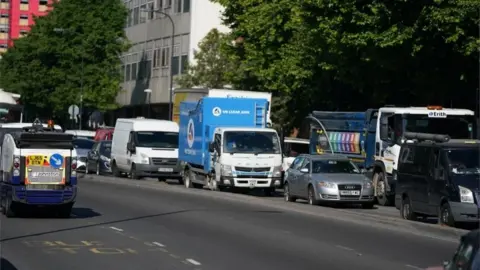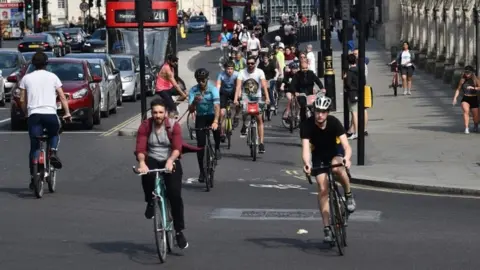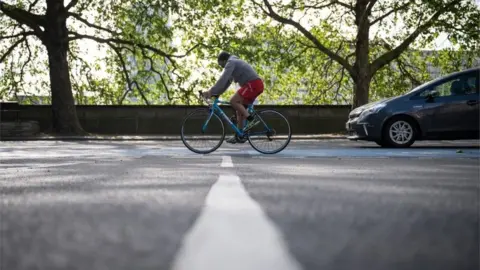Coronavirus: Will traffic in London double as lockdown eases?

 AFP
AFPGridlock. Congestion. Delays. Increased journey times. Pollution. Is this what will happen to London's already constrained roads as lockdown eases?
Transport for London (TfL) says due to social distancing, capacity on the Tube will be reduced to 15-20% and 20-25% on buses.
If nothing is done, TfL has done modelling showing you would get a doubling of car use in central London, assuming a third of pre-lockdown journeys return and those who cannot get on to public transport shift to their cars.
 PA Media
PA MediaPre-lockdown, there were about 100,000 cars a day entering the central London congestion charging zone. The modelling found that could double to 200,000.
However, this could be an underestimate and it doesn't take a genius to work out what a doubling of cars would do.
In outer London where car use is much higher, congestion could also get worse.
Before the lockdown there were 4.5 million car journeys a day in total across the capital and most of those journeys were very short - 60% were under 2.5 miles.
It is those journeys the authorities want to encourage to walk or cycle. The problem is people are attached to their cars, as one expert said "people treat them as a coat or a shopping basket".
 PA Media
PA MediaTo try and mitigate car use local authorities are creating pop-up bike lanes and widening pavements.
In the case of TfL, implementing the measures is one of the conditions of the £1.6bn bailout by the government. But the sheer numbers of journeys cycling and walking will have to absorb are considerable.
If we use TfL's latest Travel to London statistics from 2019, it shows there were 26.9m trips daily on average in London. (A trip being one-way movement from an origin to a destination for a specific purpose i.e. work, so most people take at least two trips a day).
Of those, the main mode of travel is:
- Rail: 3 million
- Underground: 2.8m
- Bus: 3.7m
- Taxi/private hire vehicle: 400,000
- Car: 5.8m
- Cycling: 700,000
- Walking: 6.7m
Compared to buses, the Tube and rail, cycling is a relatively small means of transport, however walking plays a substantial part in Londoners getting around.
A rough calculation means to keep car use constant, cycling and walking will have to accommodate 7.6m trips. TfL also says cycling could see a 10-fold increase in trips to seven million.
 AFP
AFPThere is also now an emphasis on staying and shopping local and home working. An AA survey found 20% of its members said they would work from home more.
Edmund King, from the AA, said: "I think there is a limit to the amount of cars that can enter central London because there are constraints - lack of parking is a big constraint - the congestion charge will put many people off.
"But in the outskirts of London we could see more people driving because people will be reluctant to use public transport.
"So what we are saying is if you can work from home do that, if you can walk or cycle do that.
"If you must use your car, then park on the outskirts and use other forms of transport. We'd also like park and pedal sites at places like the O2 where people could drive to and then cycle."
 Getty Images
Getty ImagesThere is also opposition to the increase in cycle lanes. The black cab lobby has called it an outrageous land grab.
And campaigners who fought cycle superhighway 11, are trying to legally challenge the cycle lanes saying they think they are disjointed.
Daniel Howard, who campaigned against CS11, says: "Fundamentally, the rise of cycle lanes in London is a good thing in terms of improving London's air quality.
"But we're extremely concerned about the fragmented and un-integrated way that Transport for London are doing this.
"They're rushing out these cycle lanes and road closures of main arterial roads in London. We really fear the impact that will have on London's businesses. London's businesses desperately need to be readily accessible. We want a much more wide ranging consultative process."
As lockdown eases, huge challenges remain for cities and transport and how to avoid a car-led renaissance.
